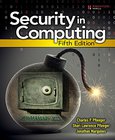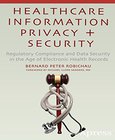Security in Computing
4th Edition

Book Details:
| Publisher: | Prentice Hall |
| Series: | Prentice Hall |
| Author: | Charles P. Pfleeger |
| Edition: | 4 |
| ISBN-10: | 0132390779 |
| ISBN-13: | 9780132390774 |
| Pages: | 880 |
| Published: | Oct 23 2006 |
| Posted: | Nov 19 2014 |
| Language: | English |
| Book format: | CHM |
| Book size: | 7.76 MB |
Book Description:
The New State-of-the-Art in Information Security: Now Covers the Economics of Cyber Security and the Intersection of Privacy and Information Security For years, IT and security professionals and students have turned to Security in Computing as the definitive guide to information about computer security attacks and countermeasures. In their new fourth edition, Charles P. Pfleeger and Shari Lawrence Pfleeger have thoroughly updated their classic guide to reflect today's newest technologies, standards, and trends. The authors first introduce the core concepts and vocabulary of computer security, including attacks and controls. Next, the authors systematically identify and assess threats now facing programs, operating systems, database systems, and networks. For each threat, they offer best-practice responses. Security in Computing, Fourth Edition , goes beyond technology, covering crucial management issues faced in protecting infrastructure and information. This edition contains an all-new chapter on the economics of cybersecurity, explaining ways to make a business case for security investments. Another new chapter addresses privacy--from data mining and identity theft, to RFID and e-voting. New coverage also includes Programming mistakes that compromise security: man-in-the-middle, timing, and privilege escalation attacks Web application threats and vulnerabilities Networks of compromised systems: bots, botnets, and drones Rootkits--including the notorious Sony XCP Wi-Fi network security challenges, standards, and techniques New malicious code attacks, including false interfaces and keystroke loggers Improving code quality: software engineering, testing, and liability approaches Biometric authentication: capabilities and limitations Using the Advanced Encryption System (AES) more effectively Balancing dissemination with piracy control in music and other digital content Countering new cryptanalytic attacks against RSA, DES, and SHA Responding to the emergence of organized attacker groups pursuing profit
Download Link:
Related Books:
Security in Computing
5th Edition
The New State of the Art in Information Security: Now Covers Cloud Computing, the Internet of Things, and Cyberwarfare Students and IT and security professionals have long relied on Security in Computing as the definitive guide to computer security attacks and countermeasures. Now, the authors have thoroughly updated this classic to reflect today's newest technologies, attacks, standards, and trends. Security in Computing, Fifth Edition, offers complete, timely coverage of all aspects of computer security, including users, software, devices, operating systems, networks, and data. Reflecting rapidly evolving attacks, countermeasures, and computing...
Healthcare Information Privacy and Security
Regulatory Compliance and Data Security in the Age of Electronic Health Records
Healthcare IT is the growth industry right now, and the need for guidance in regard to privacy and security is huge. Why? With new federal incentives and penalties tied to the HITECH Act, HIPAA, and the implementation of Electronic Health Record (EHR) systems, medical practices and healthcare systems are implementing new software at breakneck speed. Yet privacy and security considerations are often an afterthought, putting healthcare organizations at risk of fines and damage to their reputations. Healthcare Information Privacy and Security: Regulatory Compliance and Data Security in the Age of Electronic Health Records outlines the new regulatory regime, and it also provides IT professionals with the processes and protocols, standards, and governan...
The Essential Turing
Seminal Writings in Computing, Logic, Philosophy, Artificial Intelligence, and Artificial Life plus The Secrets of Enigma
Alan Turing was one of the most influential thinkers of the 20th century. In 1935, aged 22, he developed the mathematical theory upon which all subsequent stored-program digital computers are modeled. At the outbreak of hostilities with Germany in September 1939, he joined the Goverment Codebreaking team at Bletchley Park, Buckinghamshire and played a crucial role in deciphering Engima, the code used by the German armed forces to protect their radio communications. Turing's work on the version of Enigma used by the German navy was vital to the battle for supremacy in the North Atlantic. He also contributed to the attack on the cyphers known as 'Fish' which were used by the German High Command for the encryption of signals during the latter part of th...
2007 - 2021 © eBooks-IT.org



